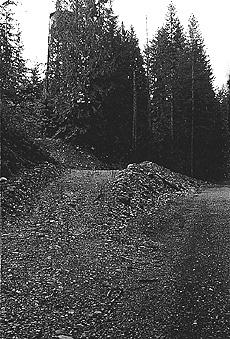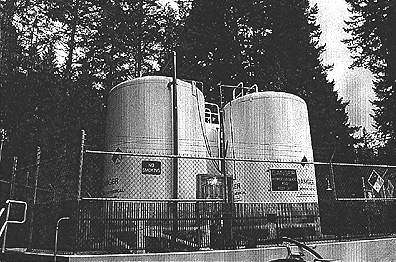
"Seattle's water system is a legacy left by far-sighted people of a century ago who had a vision and acted on it. They saw clearly the long-term potential for growth in the area and made wise decisions to secure a water supply matching that potential. Had they not vigorously pursued their vision, water in Seattle and most of King County might not be available in the quantity and quality ... it is today." -Seattle Water Department
Beginning in 1895, the City of Seattle had the vision to acquire the lands which make up the 143 square mile Cedar River watershed, home to two-thirds of Seattle's drinking water. The city is currently in the final stages of determining how to preserve the habitat that exists. As it stands now, the decision by the city will be made in the form of a 50-year Habitat Conservation Plan (HCP) created in conjunction with federal agencies.
The initial purchase of a portion of the watershed was accomplished by the approval of Seattle voters for a bond to establish a municipal water system. Its need was epitomized by the lack of water available to extinguish the Great Seattle Fire of 1889. But while the City owned a portion of the watershed, other areas of it were controlled by railroad and timber companies and the federal government.
The most notable impact on areas not controlled by the city was logging. Logging the watershed was accomplished both at the direction of logging companies as well as via the US Forest Service's program of exchanging and selling forest lands to timber companies. As concern over retaining the quality of the watershed grew, the City of Seattle began to actively pursue ownership of all lands within the watershed's boundaries. Most of this increase came from a 1992 land exchange with the US Forest Service which, after Congressional approval increased city lands to 99 percent of the watershed.
HCP: An Endangered Species Act Loophole
A Habitat Conservation Plan is "a detailed plan for the conservation of species listed as threatened or endangered under the federal Endangered Species Act" according to a Cedar River scoping report. While its stated goal is to protect endangered species, an approved HCP allows the issuance of incidental take permits if a plan to conserve the species as a whole exists. An incidental take is defined as "the harassment, harming, hunting, killing, or entrapment of an endangered species". For the Cedar River watershed, this would directly affect species like the spotted owl, marbled murrelet, and bull trout.

|
|
|
The creation of the Cedar River HCP has been a three-year process between the City of Seattle and various federal agencies, including the U.S. Fish and Wildlife Service. It currently exists in the form of an agreement in principle, however there are several additional stages before it can be approved and come into practice. The Muckleshoot tribe was also involved in the planning process, but decided not to be a signatory of the agreement in principle.
In order for the HCP to come into force, a joint environmental assessment and environmental impact statement must be conducted by federal and state agencies, the environmental studies publicly reviewed, and the final agreement approved by the Seattle City Council.
Cut Trees to Conserve Habitat?
While the city has been commended for acquiring the watershed over the years, the draft agreement has come under criticism by environmental groups. The three major concerns are allowing logging in the watershed, creating a non-native sockeye salmon hatchery, and not protecting instream flow levels. The lack of public involvement during the process has also been of concern to activists.
The most controversial aspect of the proposed HCP is funding it by allowing logging in 36 percent of the watershed. Logging in the watershed has occurred over the last 100 years and continues today. The ongoing process of logging, including clearcutting, in the watershed has destroyed all but 1400 acres of old growth forest and the creation of 550 miles of roads (out of 143 square miles). Over the past decade alone, 7,760 million board feet of wood has been taken from the watershed.
Proponents of the plan say continued logging in 36 percent of the watershed will pay for the proposed $70 million HCP. This money would be used to restore forests and streams, protect species, decommission some roads, create others, and establish a hatchery.
Checkerboard or Zero Cut?
Opponents of this funding mechanism feel there are better ways of financing the restoration and preservation of habitat without continuing logging. Proposed alternative funding sources include nominally increasing water rates, increasing sewer rates, seeking a governmental grant or charging higher prices for water purveyors during the summer.
"The purpose of the timber program is to support protection and restoration of the Cedar River forest and aquatic ecosystem, not generate

|
|
|
A more sustainable alternative is also being created by an emerging organization, the Seattle Environmental Policy Institute. One of the issues this group plans to tackle is bringing together individuals and organizations who oppose logging in the Watershed. Although in its nascent stages of formation, the goal of this group will be advocating within the City of Seattle government for better environmental policies and acting as a clearinghouse for information. The cessation of logging would lower the maintenance costs by allowing more roads to be decommissioned and decrease filtration demands caused by logging. "Based on economic considerations alone, it's wiser to have a zero cut policy rather than log it for short term profit," said Pacific Crest Biodiversity Project Director Jasmine Minbashian.
Other alternative funding sources which have been proposed during the scoping process include nominally increasing water rates, increasing sewer rates, seeking local, state, or federal governmental funding, or charging higher prices for water purveyors during the summer.
"Expensive and Ill-conceived"
A second controversial part of the proposed HCP is the creation of a non-native sockeye salmon hatchery. Hatcheries producing non-native fish yield stock which are not as strong, more prone to disease, and have lower survival rates.
"The proposed hatchery is expensive and ill-conceived...[because] hatchery-reared fish threaten wild salmon runs," said John Reese of the NW Forest Action Group. Environmentalists have suggested that the habitat of three native species, the coho, steelhead, and chinook, should be restored instead.
A final major concern with the HCP as currently proposed is the protection of instream flows. In a 1995 report, the Department of Ecology reported that Cedar River instream flows were declining, despite regulations for their protection. Environmentalists, recreationists, and fishermen would like to see a stronger commitment to protecting a normal level of instream flows. Low flows can increase the temperature of the water, marine species which prefer cool water. Normal levels would also allow sufficient water levels for fish runs and recreational uses like boating.
To give input to the HCP process, contact the Seattle Mayor's office (206) 684-4000; Diana Gale, Director Seattle Public Utilities (206) 684-5851; or Margaret Pageler, Chair of the Seattle Utilities & Environmental Management Committee (206) 684-8807
Scott Denburg is a masters student at the University of Washington. His studies include public policy and environmental affairs.
 |
 |
 |
 |
 |